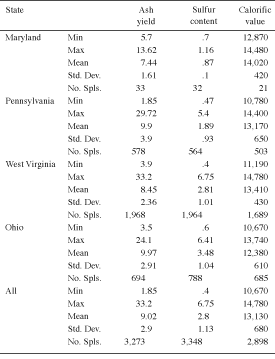The Pittsburgh Coal Bed -- An Example Assessment
The Pittsburgh coal bed (fig. 2), the top producer in the northern Appalachian region and the second largest producer in the Nation, is the first of the six coal beds in the northern and central Appalachian basin coal region to undergo full digital assessment. We are presenting data for the Pittsburgh coal bed as an example of the type of information that is being compiled during the assessment of coal resources in the Appalachian basin.

Figure 2. Extent of the Pittsburgh coal bed and its stratigraphically equivalent horizon (which is represented by thin or absent coal or insufficient data), areas of known mining, and areas that contain resources that are not presently mined. From Ruppert, Tewalt, and Bragg, 1997.
|
The stratigraphic database contains more than 5,000 descriptions from drill cores, mine locations, and outcrops, with an additional 2,000 records that contain data on coal elevation. The geochemical database consists of about 3,400 analyses of ash yield, sulfur content, and calorific value and about 160 analyses of selected major, minor, and trace elements. In addition, more than 100 paper maps at scales ranging from 1:24,000 to 1:250,000 were digitized to create a single GIS coverage of the extent of the coal bed.
For each of the subject coal beds, a number of maps will summarize the information contained in the databases. The CD-ROM will provide maps of total extent and mined area (fig. 2), structure contour (or coal bed elevation) (fig. 3), overburden thickness (the material that overlies the coal) (fig. 4), and coal bed thickness (fig. 5). Table 1 presents mean ash yield, sulfur content, and calorific value (on an as-received basis) by State. In addition to these maps and charts, the CD-ROM will provide summary geologic cross sections, stratigraphic columns (fig. 6), and point-and-click maps that will allow the user to easily retrieve data for specific map localities. Resource information will also be available by State and county. In addition to the CD-ROM, the material compiled for each of the six major producing beds will be available on the World Wide Web.

Figure 3. Top of the Pittsburgh coal bed. The structure contour interval is 50 feet. From Tewalt, Ruppert, Bragg, Carlton, Brezinski, Yarnell, and Wallack, 1997, sheet 1.
|

Figure 4. Overburden thickness or the thickness of the rock and soil that lie above the Pittsburgh coal bed. The thickness was derived by subtracting the elevation of the Pittsburgh coal bed from digital models that represent surface elevation. Overburden thickness categories are defined by mining practices and USGS coal resource methodology. From Tewalt, Ruppert, Bragg, Carlton, Brezinski, Yarnell, and Wallack, 1997, sheet 2.
|

Figure 5. Thickness of the Pittsburgh coal bed, as represented by isopach lines or thickness contours, generalized to remove local variations. Thickness contours are presented at 2-foot intervals. From Tewalt, Ruppert, Bragg, Carlton, Brezinski, and Wallack, 1997.
|
|
Table 1. State averages of ash yield (percent), sulfur content (percent), and calorific value (British thermal units per pound) for the Pittsburgh coal bed on an as-received basis.
[Min = minimum; Max = maximum; Std. Dev. = standard deviation; No. Spls. = number of samples]

|

Figure 6. Generalized stratigraphic column of the Upper Pennsylvanian Monongahela Group. The Pittsburgh coal bed divides the Monongahela Group from the underlying Conemaugh Group strata in the Appalachian basin. From Tewalt, Ruppert, Bragg, Carlton, Brezinski, and Wallack, 1997.
|

Figure 7. Original and remaining resources of the Pittsburgh coal bed in Maryland, Ohio, Pennsylvania, and West Virginia.
|
The Pittsburgh coal bed data also allow estimation of the amount of original resource and the tonnage that remains. The results of this analysis are summarized by State in figure 7. Of an original 34 billion short tons, 16 billion short tons of resource remain. The data also clearly indicate that the best of the remaining resource is in southwestern Pennsylvania and adjacent areas of West Virginia (fig. 2), where blocks of medium ash (>8 to <15 weight percent) and medium sulfur (>1 to <3 weight percent) coal remain.
The remaining available, recoverable resource is less than 16 billion short tons. Various constraints on mining, including Federal and State mining regulations, land use and environmental regulations and concerns, geologic and technical factors, and economic realities limit the amount of the coal resource that is actually available for production. Studies completed in various regions within the eastern coal fields indicate that the recoverable resources may be as small as 4 percent of the original in-place amount.
|









